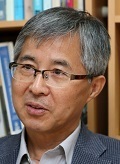 |
|
On July 15, the New York Times published an article comparing Japanese Prime Minister Shinzo Abe’s export controls to the trade policies of US President Donald Trump. (Hankyoreh archives)
|
The current S. Korea-Japan trade dispute a remnant of imperialism and Cold War era
The conflict between South Korea and Japan is assuming greater proportions with each passing day. Though the trade dispute began with the Abe administration placing restrictions on Japanese exports of three items, including high-purity hydrogen fluoride, to South Korea, it’s escalating beyond the economic domain. The Hankyoreh has been covering South Korea’s dependence on Japanese parts and materials and Japan’s white list. The newspaper’s articles have also shed light on South Koreans’ boycott of Japanese products and their cancellation of planned trips to Japan. Articles in the Japanese and English-language media about the two countries’ spat has illustrated how this issue is being regarded abroad. It has received less coverage in other countries in East Asia, such as China or Taiwan. An understanding of this dispute requires a more historical approach because of its connection to changes in East Asia resulting from the legacy of imperialism and the Cold War. East Asia is the only region in the world that’s still dealing with that legacy. Japan succeeded at achieving Western-style development under the mantra of “Datsu-A Ron,” or de-Asianization. While seeking to expand its territory on the model of Western imperialism, Japan colonized Korea, then known as Joseon. It was Japan that provoked World War II, the most horrific war in human history, endangering young Korean men and women. While the war ended in Japan’s defeat, Japan’s conservative political forces long for the country’s glory days, rather than repenting of its past deeds. They denigrate repentance as self-flagellation and distort history by praising the age of imperialism. The current situation in Japan is the product of the Cold War. While the US and the Soviet Union had fought together against Germany, Italy, and Japan in World War II, they became the poles of two competing systems after the war. In 1947, an American diplomat at the US embassy to Moscow named George Kennan submitted a piece to Foreign Affairs, under the pseudonym “Mr. X,” in which he argued that Stalinist expansionism was a threat to democracy and advocated a strategy of containment against the Soviet Union. President Truman bought into this viewpoint, leading him to scrap FDR’s plan of working with the Soviet Union and China to build a peace regime in Northeast Asia and declared the Truman Doctrine, with the goal of containing those two countries. The emergence of the Cold War also led the allies’ General Headquarters (GHQ), led by General Douglas MacArthur, in Japan to halt its efforts to institute democratic reforms and dismantle militarism in that country. The allied command adopted a policy known as the Reverse Course, in which it curtailed the executions of war criminals and gave Japan’s militaristic forces a second chance in the hope that Japan would serve as a counter to the Soviet Union. Japan was transformed from a country of war criminals into the US’ Asian partner in its containment of Soviet and Chinese expansion. Furthermore, the Korean War, which began in 1950, brought a huge economic boom to Japan. Given Japan’s geographical proximity to the Korean Peninsula, the US used it as a source of war supplies, enabling Japan to earn a total of US$2.5 billion from the US during the three years of the war. At the time, Japanese Prime Minister Shigeru Yoshida called the Korean War “a blessing from the heavens.” After the travails of the colonial occupation, the Korean Peninsula was devastated during the war, but Japan was flush with cash from the wartime boom. During the Cold War, the US arranged for South Korea and Japan to normalize their diplomatic relations through a bilateral agreement signed in 1965 and to stand together in the fight against the communist world. Despite large-scale protests by university students, the South Korean government, under President Park Chung-hee, declared martial law and hastily signed the agreement, called the Treaty on Basic Relations between Japan and the Republic of Korea. Thus, relations between the two countries were established before they could properly reckon with Japan’s colonial depredation of Korea. During the late 20th century, there have been huge economic changes in East Asia. Japan has been suffering a protracted economic slowdown since 1995, while China has enjoyed rapid growth, overtaking Japan in 2009 to become the world’s second-largest economy. South Korea has become an economic powerhouse in its own right, currently ranking 11th in the world. The gross domestic product (GDP) of China, Japan, and South Korea has narrowed to a ratio of 8:3:1, a reality that’s hard to swallow, and even nerve-wracking, for Japan’s conservatives.
 |
|
Shin Gwang-yeong, professor of sociology at Chung-Ang University
|







